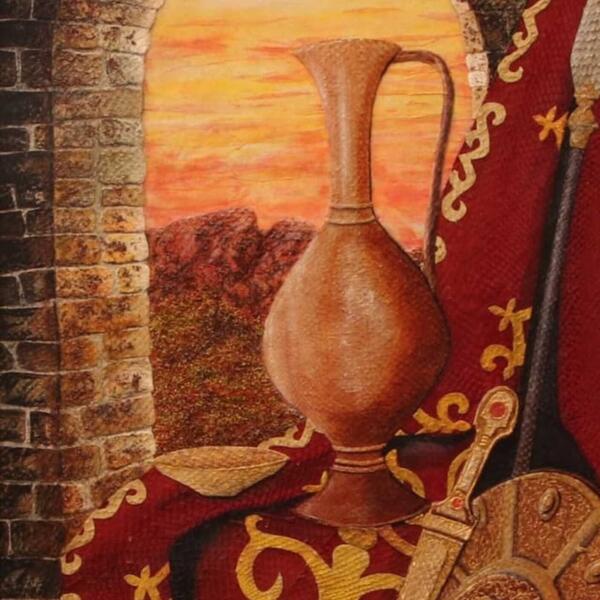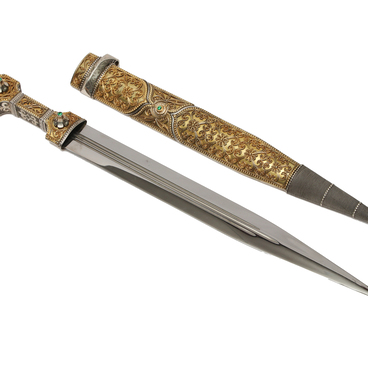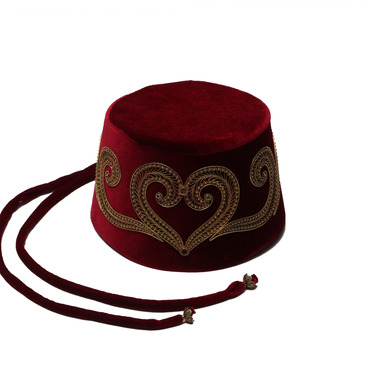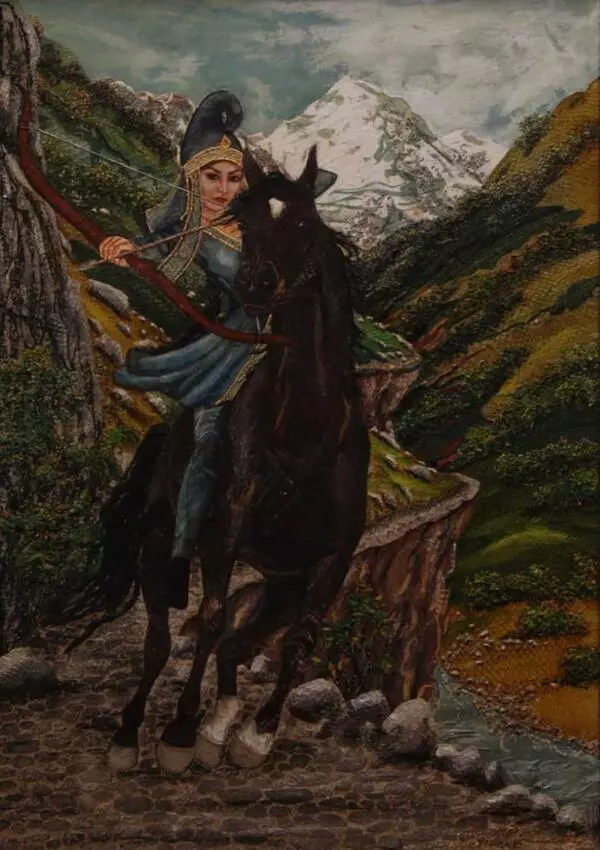In her still life ‘The Ingush Motifs’, artist Lida Ozdoeva depicted the most important cultural symbols of her people.
In the center of the canvas, she depicted a traditional felt carpet made of sheep wool and decorated with symbolic patterns. It is called ‘isting’. The large yellow symbol in the center is one of the earliest preserved ancient ornaments, it was recorded by artist Gazi-Magomed Daurbekov in the Ingush village of Nasyr-Kort. It symbolizes the tree of life. A smaller pattern, which is clearly visible in the lower left corner of the artwork, is a figure of a praying man with his hands raised up.
The artist also highlighted the local traditional weapons: next to the shield lies a dagger in a richly decorated scabbard. Since the ancient times, every young man in Ingushetia began carrying a dagger from the age of 14 or 15, and the decor and quality of the weapon reflected the character and social status of its owner. Traditionally, the dagger was double-edged, it could function as a knife and axe: well-sharpened iron can easily cut even trough bone and small trees.
The handle of the dagger was made of bone, much less often — of horn. The two halves were assembled, fastened with rivets or silver fasteners, and decorated with a notch or engraving. Daggers and sabers made by the best masters were very expensive: their price was comparable to the cost of the best horse or a flock of sheep.
The author of this still life, Lida Ozdoeva was born on January 17, 1974 in Kokchetav, Kazakh Soviet Socialist Republic. She graduated from the Professional College in Nazran as tailor-patternmaker. Her childhood love for drawing grew into a serious passion for painting and arts and crafts. Although she has not received a specialized education, she has been engaged in the art world all her life: she worked at a school as an artist-decorator, taught a course ‘History of styles. Artistic Design of Clothing’ at the college of Service and Household in Nazran.
She began to create artworks using fish skin leather thanks to Ingush entrepreneur Akhmed Shadiev — he developed a technology of fish skin processing and dyeing and began to make clothes and accessories from it. He suggested that the artist could try these unusual materials instead of paints.
Since then, Lida Ozdoeva creates artworks using fish skin. For each work she chooses different skins, taking into account the color and texture of the material.
In the center of the canvas, she depicted a traditional felt carpet made of sheep wool and decorated with symbolic patterns. It is called ‘isting’. The large yellow symbol in the center is one of the earliest preserved ancient ornaments, it was recorded by artist Gazi-Magomed Daurbekov in the Ingush village of Nasyr-Kort. It symbolizes the tree of life. A smaller pattern, which is clearly visible in the lower left corner of the artwork, is a figure of a praying man with his hands raised up.
The artist also highlighted the local traditional weapons: next to the shield lies a dagger in a richly decorated scabbard. Since the ancient times, every young man in Ingushetia began carrying a dagger from the age of 14 or 15, and the decor and quality of the weapon reflected the character and social status of its owner. Traditionally, the dagger was double-edged, it could function as a knife and axe: well-sharpened iron can easily cut even trough bone and small trees.
The handle of the dagger was made of bone, much less often — of horn. The two halves were assembled, fastened with rivets or silver fasteners, and decorated with a notch or engraving. Daggers and sabers made by the best masters were very expensive: their price was comparable to the cost of the best horse or a flock of sheep.
The author of this still life, Lida Ozdoeva was born on January 17, 1974 in Kokchetav, Kazakh Soviet Socialist Republic. She graduated from the Professional College in Nazran as tailor-patternmaker. Her childhood love for drawing grew into a serious passion for painting and arts and crafts. Although she has not received a specialized education, she has been engaged in the art world all her life: she worked at a school as an artist-decorator, taught a course ‘History of styles. Artistic Design of Clothing’ at the college of Service and Household in Nazran.
She began to create artworks using fish skin leather thanks to Ingush entrepreneur Akhmed Shadiev — he developed a technology of fish skin processing and dyeing and began to make clothes and accessories from it. He suggested that the artist could try these unusual materials instead of paints.
Since then, Lida Ozdoeva creates artworks using fish skin. For each work she chooses different skins, taking into account the color and texture of the material.





